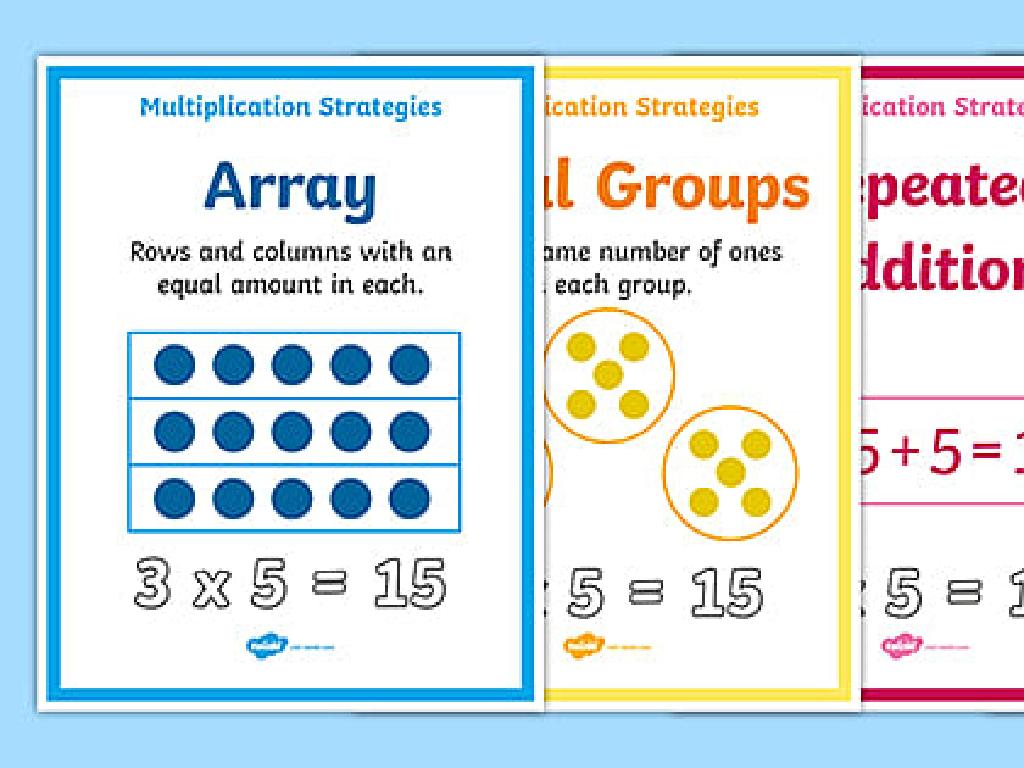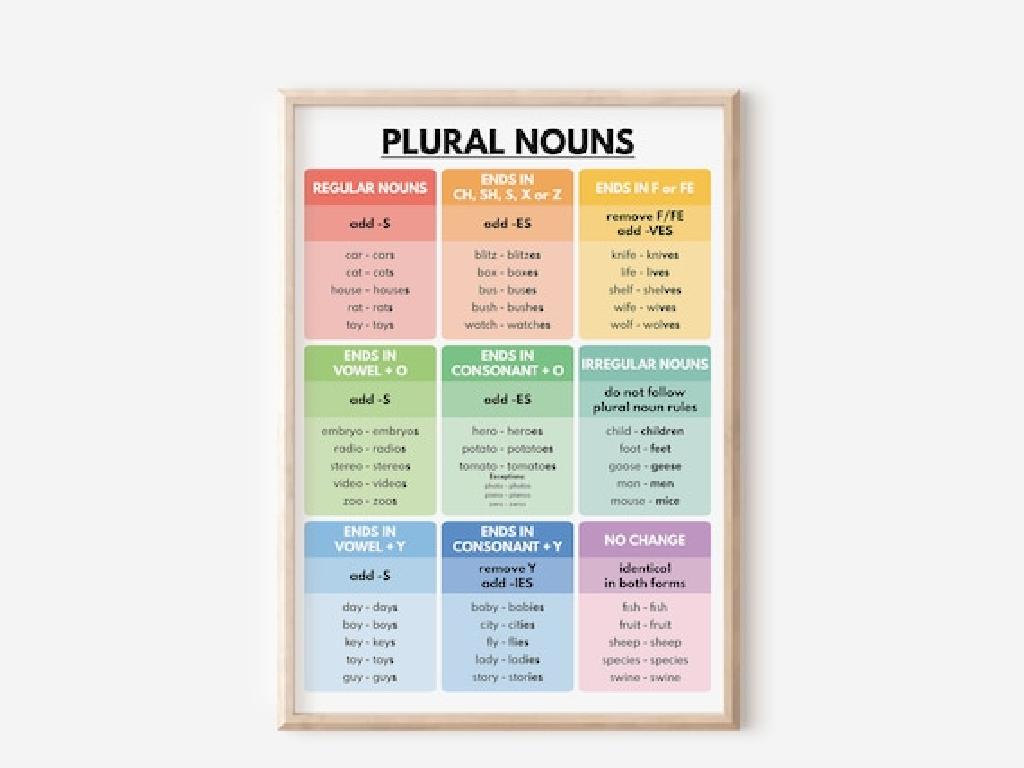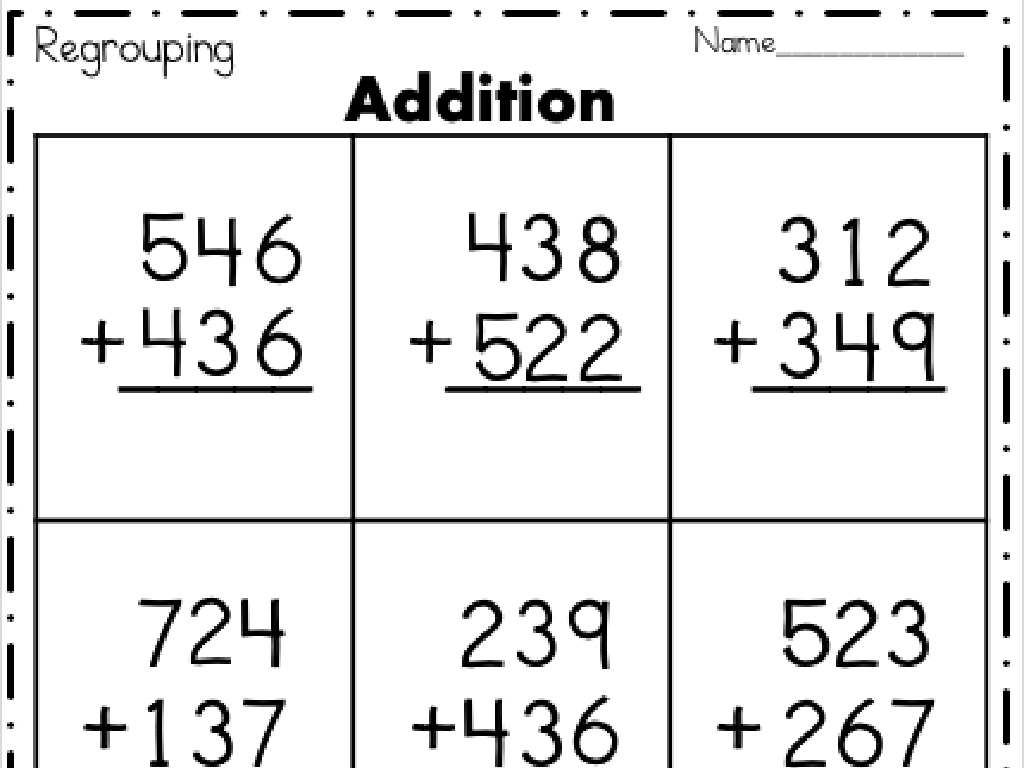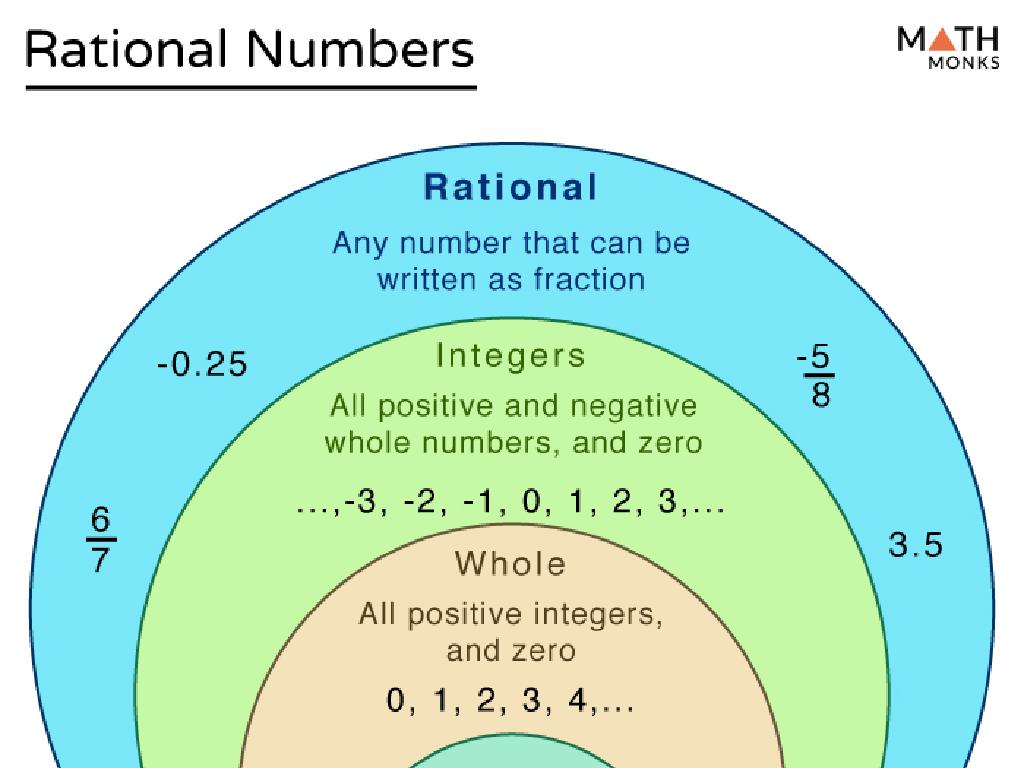Identify Properties Of An Object
Subject: Science
Grade: Third grade
Topic: Materials
Please LOG IN to download the presentation. Access is available to registered users only.
View More Content
Welcome to Materials Science!
– Learn about object properties
– Properties tell us how things look, feel, and can be used
– Discover materials’ importance
– Different materials are used for different purposes based on their properties
– Become material detectives
– We’ll investigate everyday objects to learn what they’re made of
– Why properties matter
– Understanding properties helps us choose the right material for a task
|
This slide introduces the concept of materials science to third graders, focusing on the properties of objects. Start by explaining that everything around us is made of different materials, each with its own set of properties. These properties can include color, shape, texture, and size. Emphasize the importance of materials in our daily lives and how understanding their properties can help us make better decisions. For example, why are umbrellas made of plastic rather than paper? Engage the students by encouraging them to think like detectives, examining objects around them to deduce what materials they are made from and why those materials are suitable for their purpose. This will set the stage for hands-on activities where students can explore and identify properties of various objects in the classroom.
Exploring Materials and Their Properties
– Understanding materials
– Materials are substances objects are made from.
– Common materials around us
– Examples: Wood is from trees, Plastic is man-made, Metal is from ores, Glass is made by heating sand, Fabric is woven from fibers.
– Properties make materials unique
– Properties are qualities like strength, flexibility, and texture.
– Observing material properties
|
This slide introduces the concept of materials in everyday objects, aiming to help students recognize and categorize materials they interact with daily. Discuss the origin of different materials such as wood, plastic, metal, glass, and fabric. Highlight that each material has specific properties that make it suitable for certain uses, like metal being strong for construction or fabric being flexible for clothing. Encourage students to touch and feel different objects to understand their properties. This tactile approach will help solidify their understanding of the material properties.
Properties of Materials
– What are properties?
– Properties are qualities like color and shape
– Common properties of objects
– Color, shape, texture, hardness, flexibility
– Importance of properties
– Helps us decide what material to use
– Choosing materials based on properties
– Pick the right material for the job
|
This slide introduces the concept of properties of materials to third-grade students. Begin by explaining that properties are the special qualities or characteristics that something has. Give examples of common properties such as color, shape, texture, hardness, and flexibility. Discuss why understanding these properties is crucial when we choose materials for different purposes. For instance, we choose soft materials like cotton for clothes and hard materials like metal for tools. Encourage students to think about the properties of items they use every day and why those properties make the materials suitable for their specific uses.
Observing Properties Like Scientists
– Scientists use senses and tools to observe
– Engage senses: Look, Touch, Smell, Listen
– Observe color, shape, texture, and more
– Classroom objects observation activity
– Use magnifying glasses to see details
– Describe each object’s properties
– Record observations in science notebooks
|
This slide introduces the concept of observing properties of materials, a key skill for young scientists. Emphasize the importance of using senses and tools to gather information about an object’s properties such as color, shape, texture, and sound. During the activity, provide a variety of classroom objects for students to examine and describe. Encourage them to use magnifying glasses to observe finer details and to smell objects when it is safe to do so. Guide them to listen to the sounds objects make when used or manipulated. Have students record their observations in their science notebooks, fostering their skills in scientific inquiry and documentation. This activity will help students understand that careful observation is the first step in identifying properties of materials.
Exploring Object Properties: Color and Shape
– Colors of objects vary
– Some are bright, others less visible
– Objects have different shapes
– From round apples to long bananas
– Activity: Fruit property hunt
– Find fruits of different colors and shapes
|
This slide introduces the concepts of color and shape as observable properties of objects. Explain that objects can have a wide range of colors, from very bright and easy to see to having no color at all. Discuss how the shape of an object is its form, such as round, square, or any other outline. For the class activity, students will identify and categorize fruits based on their color and shape, enhancing their understanding of these properties. Possible activities include a fruit scavenger hunt, drawing fruits and labeling their colors and shapes, or grouping fruits brought from home. This will help students to apply the concepts of color and shape to real-life objects and improve their observational skills.
Exploring Texture and Hardness
– Texture: Surface feel of materials
– Is it rough, smooth, bumpy, or soft?
– Hardness: Resistance to scratches
– Can you scratch it easily with a fingernail?
– Activity: Comparing materials
– Feel and press a sponge versus a rock
– Discuss: Texture vs. Hardness
|
This slide introduces the concepts of texture and hardness as properties of materials. Texture refers to the tactile sensation we experience when we touch the surface of an object, which can vary widely from rough to smooth or bumpy to soft. Hardness measures how resistant a material is to being scratched, which can help us understand its durability. For the class activity, provide a variety of materials such as sponges, rocks, fabrics, and plastics for students to touch and try to scratch. This will help them grasp the differences between texture and hardness. Encourage students to describe what they feel and observe, and discuss why understanding these properties is important in everyday life and in science.
Properties of Materials: Flexibility and Strength
– What is flexibility?
– Flexibility means being able to bend without breaking.
– Understanding strength
– Strength is the ability to hold weight or resist force.
– Class activity: Test flexibility
Try bending a paperclip and see if it breaks.
– Class activity: Test strength
Try to snap a pencil by applying force. Can it hold?
|
This slide introduces the concepts of flexibility and strength as properties of materials. Flexibility refers to a material’s ability to bend without breaking, which can be demonstrated by bending a paperclip. Strength refers to the ability of a material to withstand forces such as weight or pressure without breaking or deforming, as shown by trying to break a pencil. For the class activity, provide paperclips and pencils for students to test these properties. Encourage them to observe and discuss why some materials are more flexible or stronger than others. This will help them understand how different materials are suitable for different uses based on their properties.
Class Activity: Material Hunt
– Explore the classroom on a material hunt
– Find objects and describe their properties
– Look for size, shape, color, and texture
– Record your findings on the Detective Sheet
– Share what you discovered with the class
– Tell us about the objects and their uses
|
This activity is designed to help students apply their knowledge of materials and their properties in a fun and interactive way. Set up stations around the classroom with various objects made of different materials such as metal, plastic, wood, and fabric. Provide each student with a ‘Material Detective Sheet’ where they can write down the name of the object, its material, and its properties like size, shape, color, and texture. Encourage them to touch and feel each object (where safe and appropriate) to better understand the texture. After the hunt, ask students to share interesting findings and discuss how the properties of the materials make them suitable for their purposes. This will reinforce their understanding of materials and their properties.
Review and Share: Material Properties
– Recap our material hunt findings
– Share an interesting property
– Maybe you found something shiny, magnetic, or very strong!
– Discuss the usefulness of knowing properties
– Understanding material properties helps us choose the right material for a task
– Reflect on properties and their uses
– Think about how different materials are used in everyday objects
|
This slide aims to consolidate the students’ learning from a previous activity where they explored different materials and their properties. Encourage the students to think about the materials they encountered during their ‘material hunt’ and share the most interesting property they found. This could be a material’s texture, flexibility, or color. Discussing the importance of material properties helps students understand why certain materials are used for specific purposes, such as metal for building because of its strength. Have students reflect on how this knowledge can be applied in real life, such as in choosing materials for their own projects or understanding how objects around them are made.
Junior Material Detectives: Conclusion
– Congrats on becoming detectives!
– Properties of materials are everywhere
– Think about how different objects feel and look
– Keep observing like a scientist
– Notice textures, colors, and shapes in daily life
– Always ask questions about materials
– What makes glass different from wood or metal?
|
This slide wraps up the lesson by celebrating the students’ new understanding of material properties. Encourage them to continue observing the world around them with a curious and analytical mind. Reinforce the idea that the properties of materials, such as texture, color, hardness, and flexibility, can be found in everyday objects. Prompt them to think about the materials they interact with daily and to ask questions about why materials are used for certain objects. This will help them apply their knowledge outside of the classroom and see the relevance of science in their lives.






